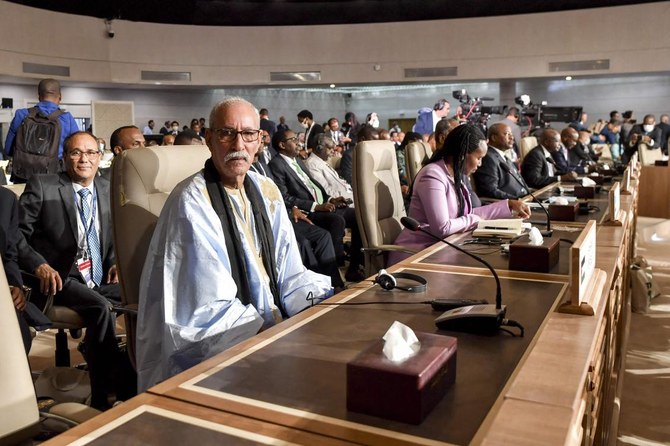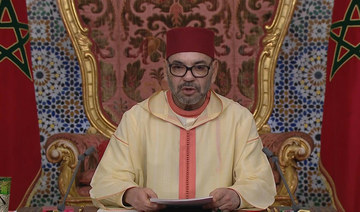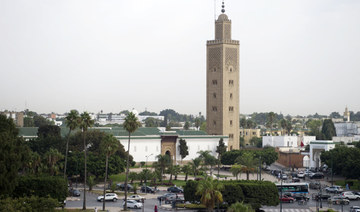TUNIS: Tunisia said Saturday it would recall its ambassador from Morocco for consultations, a day after the kingdom did the same in response to Tunisia’s president hosting the Polisario movement’s head.
The Polisario wants an independent state in the Western Sahara, a vast stretch of mineral-rich desert which Morocco sees as a sovereign part of its own territory.
Tunisian President Kais Saied had on Friday hosted Polisario chief Brahim Ghali who arrived to attend the Japanese-African investment conference TICAD.
In response to what it called a “hostile” and “unnecessarily provocative” act, Morocco immediately withdrew its Tunis ambassador for consultations and canceled its own participation in the high-profile conference.
On Saturday the Tunisian Foreign Ministry voiced its “surprise” at Morocco’s reaction.
“Tunisia has maintained its total neutrality on the Western Sahara issue in line with international law,” it said in a statement.
“This position will not change until the concerned parties find a peaceful solution acceptable to all.”
Saied spent much of Friday welcoming African leaders arriving for the TICAD conference, including Ghali who is also president of the self-proclaimed Sahrawi Arab Democratic Republic (SADR).
Morocco accused Tunisia of “unilaterally” inviting the Polisario chief “against the advice of Japan and in violation of the process of preparation and established rules.”
But Tunisia said Saturday the African Union had issued a direct invitation to the SADR, a member state, to join the conference, noting that it had attended previous such gatherings — alongside Morocco.
The move came as French President Emmanuel Macron visited Morocco’s arch-rival and Polisario backer Algeria for a three-day visit aimed at healing ties with the former French colony.
It is not the first time that Ghali’s travels have sparked Moroccan anger.
In April 2021, he headed to Spain to be treated for Covid-19, sparking a year-long diplomatic row between Spain and the North African kingdom.
That only ended after Madrid dropped its decades-long stance of neutrality over the Western Sahara — a former Spanish colony — and backed a Moroccan plan for limited self-rule there.
The Polisario had waged an armed struggle before agreeing to a cease-fire in 1991 on the promise of a UN-supervised referendum on self-determination, which has never happened.
The African Union’s chairman Macky Sall, in a speech to TICAD delegates on Saturday, said he “regretted the absence of Morocco.”
“We hope that this problem will find a solution for the smooth running of our partnership” between Africa and Japan, he said.
Tunisia recalls Morocco envoy in Western Sahara row
https://arab.news/b2sfj
Tunisia recalls Morocco envoy in Western Sahara row

- Tunisian President Kais Saied had hosted Polisario chief Brahim Ghali who arrived in Japanese-African investment conference
- Morocco earlier withdrew its Tunis ambassador and canceled its participation in the conference
Rescuers in Iran trying to reach a helicopter involved in an ‘incident’ while accompanying president
Rescuers in Iran trying to reach a helicopter involved in an ‘incident’ while accompanying president

DUBAI: Rescuers in Iran are trying to reach a helicopter involved in “an incident” while traveling with an entourage including President Ebrahim Raisi, state television reported Sunday.
There was no immediate elaboration on what happened to the helicopter, nor who was on board. Semiofficial news agencies offered varying explanations for what was happening.
Raisi was traveling in Iran’s East Azerbaijan province. State TV described the area of the incident happening as being near Jolfa, a city on the border with with the nation of Azerbaijan, some 600 kilometers (375 miles) northwest of the Iranian capital, Tehran.
Raisi had been in Azerbaijan early Sunday to inaugurate a dam with Azerbaijan’s President Ilham Aliyev. The dam is the third one that the two nations built on the Aras River.
Iran flies a variety of helicopters in the country, but international sanctions make it difficult to obtain parts for them. Its military air fleet also largely dates back to before the 1979 Islamic Revolution.
Raisi, 63, is a hard-liner who formerly led the country’s judiciary. He is viewed as a protégé of Iran’s Supreme Leader Ayatollah Ali Khamenei and some analysts have suggested he could replace the 85-year-old leader after his death or resignation from the role.
‘Goodbye Julia’ wins big at Critics Awards for Arab Films in Cannes

DUBAI: Sudanese first-time director Mohamed Kordofani’s “Goodbye Julia” won the best feature film and best screenplay awards at the eighth Critics Awards for Arab Films that took place on the sidelines of the Cannes Film Festival on Saturday.
French-Tunisian composer Amin Bouhafa, who worked on “Hajjan,” won the best music award for the Saudi Arabia-based film.
Tunisian director Kaouther Ben Hania’s hybrid docudrama “Four Daughters,” which missed out on the Best Documentary win at this year’s Academy Awards, scored three prizes: Best director for Ben Hania, best documentary and best editing.
Amjad Al-Rasheed’s “Inshallah a Boy” picked up the best actress prize for Palestinian star Mouna Hawa and best cinematography for Kanamé Onoyama.
Palestinian actor Saleh Bakri nabbed the best actor prize for his role in “The Teacher” while Egyptian filmmaker Morad Mostafa’s “I Promise You Paradise” came out on top in the best short film category.
The awards ceremony is organized by the Cairo-based Arab Cinema Centre (ACC) and winners are voted on by 225 critics from more than 70 countries.
KFUPM’s 10th design expo celebrates student ingenuity

DHAHRAN: The King Fahd University of Petroleum and Minerals hosted its tenth Design Expo on Saturday, with senior students’ graduation projects highlighting solutions to real industry problems.
President of the university, Mohammed Al-Saggaf, spoke to each team and handed out awards. It was during his tenure as president that the new model for the expo was put into place.
“This exhibition is distinguished by the collaborative effort among students from different majors to create innovative projects,” the university said in a statement.
Mimicking industry standards, the university event also briefs the soon-to-be professionals on how to pitch and speak about their projects to the public, potential investors and educators.
“This exhibition will showcase various academic projects presented by our students in diverse fields,” the statement said.
A total of 1,063 students participated to present 185 projects “devising solutions for industrial challenges” in the following categories: artificial intelligence, automation technology, construction technology, digital transformation, drone technology, energy systems, environmental technology, health care technology, renewable energy, sustainability and technology enhancement.
The winning projects included an autonomous wheelchair that uses electromyography — EMG — a technique for evaluating and recording the electrical activity produced by skeletal muscles.
Prizes were also awarded for the most entrepreneurial project, the most innovative project and the best elevator pitch, along with an award based on public voting and the president’s choice award.
The most humanitarian project award was handed to “Quick-Construct Housing for Refugees and the Impoverished,” to six students: Alwaleed Talal Abutaleb and Abdulaziz Talal Abutaleb from the architectural engineering and construction management program; Ayoub Abdullah Alsalamah from mechanical engineering; Ammar Omar Alhawsawi from electrical engineering; and Faris Abdulrahman Alsuhaibani and Bander Nasser Almubaddel from aerospace engineering.
“All of this is Saudi-made, even the manufacturing process. It’s the first of its kind in Saudi Arabia, the mechanism and everything — from designing to construction — was assembled by a Saudi company,” Almubaddel told Arab News.
In a record three minutes, the structure can be built and lived in almost instantly. Their target is the refugees in the Middle East — to offer durable, affordable, portable shelter that can be assembled easily and efficiently.
Abutaleb, who focused on the architectural elements, said: “What we brought to the table (is) that we designed the unit, the dimension, the process and the interior of the unit. We are responsible for the integration of the system within the unit, in addition to the construction and the assembling.”
Electrical engineering student Alhawsawi said: “I contributed the power system and all the connections required; and all the power systems that will be integrated into the unit.”
Aerospace engineering student Alsuhaibani added: “The unit is very simple to assemble — these materials that we used to construct the unit have a very high resistance for the heat. It has item resistance, and it can withstand the harsh environment in Saudi Arabia.”
The team will continue to work on the project beyond the classroom to make it useful in the real world.
Saudi banks’ money supply surges 8% in March to reach $753bn

RIYADH: Saudi banks’ money supply rose 8 percent in March, as compared to the same month last year, to reach SR2.82 trillion ($753 billion), official data showed.
According to the data released by the Saudi Central Bank, also known as SAMA, the increase was mainly fueled by a roughly 21 percent surge in banks’ term and savings accounts, reaching SR843.25 billion. These deposits represented the second-largest portion, comprising 30 percent of the total money supply, following demand deposits, which constituted 50 percent at SR1.41 trillion.
On the other hand, quasi-money holdings made up 21 percent of the total, experiencing a 1 percent decrease during this period. Meanwhile, currency outside banks accounted for an 8 percent share, showing a 10 percent growth.
Multiple factors influenced the upsurge in term deposits. Firstly, the elevated interest rate environment within the Kingdom, shaped by the US Federal Reserve’s anti-inflationary monetary policy, has spurred individuals and entities to seek higher returns through these accounts.
Moreover, the increase in accounts held by government-related entities played a significant role. As per Fitch Ratings, these entities opted to channel their surplus liquidity into term deposits with commercial banks, thereby boosting the growth trajectory of such accounts.
It is noteworthy that during 2022, SAMA raised key policy rates seven times, followed by an additional four increases in 2023. The central bank’s repo rate was last raised by 25 basis points to 6 percent in its July 2023 meeting, marking its highest level since 2001. Since then, rates have remained unchanged.
Meanwhile, US inflation surged to a six-month high in March, prompting investors to delay their expectations for Federal Reserve rate cuts.
Deposits represent a costly funding source for banks, with heightened competition in the financial market significantly driving up their average cost.
Despite this, the surge in interest rates also strengthened Saudi banks’ profits on the asset side. Higher borrowing rates led to increased income, offsetting the challenges posed by the expensive funding environment.
On the asset side, Saudi bank loans grew by 11 percent during this period to reach SR2.67 trillion; therefore, lending growth among Saudi banks outpaced deposits.
In their April report, S&P Global suggested that Saudi financial institutions would explore alternative funding strategies to manage the rapid increase in lending, driven by rising demand for new mortgages.
The credit-rating agency noted that the funding profiles of financial institutions in the Kingdom will undergo changes, mainly due to a government-supported initiative aimed at boosting homeownership.
According to their analysis, mortgage financing accounted for 23.5 percent of Saudi banks’ total credit allocation by the end of 2023, compared to 12.8 percent in 2019.
They highlighted that the ongoing financing needs of the Vision 2030 economic initiative, coupled with relatively sluggish deposit growth, are likely to prompt banks to seek alternative budget sources, including external funding.
S&P Global anticipated this trend to persist, especially as corporate lending assumes a more significant role in growth in the coming years.
The report indicated that Saudi banks are expected to adopt alternative funding strategies to support this expansion. It also noted that the stability of Saudi deposits mitigates the risk posed by maturity mismatch.
Furthermore, the agency projected an increase in Saudi banks’ foreign liabilities, rising from approximately $19.2 billion by the end of 2023, to meet the funding demands of robust lending growth, particularly amidst slower deposit expansion.
The report emphasized that Saudi banks have already tapped into international capital markets, and S&P Global anticipates this trend to continue over the next three to five years.
KFUPM’s 10th design expo celebrates student ingenuity

DHAHRAN: The King Fahd University of Petroleum and Minerals hosted its tenth Design Expo on Saturday, with senior students’ graduation projects highlighting solutions to real industry problems.
President of the university, Mohammed Al-Saggaf, spoke to each team and handed out awards. It was during his tenure as president that the new model for the expo was put into place.
“This exhibition is distinguished by the collaborative effort among students from different majors to create innovative projects,” the university said in a statement.
Mimicking industry standards, the university event also briefs the soon-to-be professionals on how to pitch and speak about their projects to the public, potential investors and educators.
“This exhibition will showcase various academic projects presented by our students in diverse fields,” the statement said.
A total of 1,063 students participated to present 185 projects “devising solutions for industrial challenges” in the following categories: artificial intelligence, automation technology, construction technology, digital transformation, drone technology, energy systems, environmental technology, health care technology, renewable energy, sustainability and technology enhancement.
The winning projects included an autonomous wheelchair that uses electromyography — EMG — a technique for evaluating and recording the electrical activity produced by skeletal muscles.
Prizes were also awarded for the most entrepreneurial project, the most innovative project and the best elevator pitch, along with an award based on public voting and the president’s choice award.
The most humanitarian project award was handed to “Quick-Construct Housing for Refugees and the Impoverished,” to six students: Alwaleed Talal Abutaleb and Abdulaziz Talal Abutaleb from the architectural engineering and construction management program; Ayoub Abdullah Alsalamah from mechanical engineering; Ammar Omar Alhawsawi from electrical engineering; and Faris Abdulrahman Alsuhaibani and Bander Nasser Almubaddel from aerospace engineering.
“All of this is Saudi-made, even the manufacturing process. It’s the first of its kind in Saudi Arabia, the mechanism and everything — from designing to construction — was assembled by a Saudi company,” Almubaddel told Arab News.
In a record three minutes, the structure can be built and lived in almost instantly. Their target is the refugees in the Middle East — to offer durable, affordable, portable shelter that can be assembled easily and efficiently.
Abutaleb, who focused on the architectural elements, said: “What we brought to the table (is) that we designed the unit, the dimension, the process and the interior of the unit. We are responsible for the integration of the system within the unit, in addition to the construction and the assembling.”
Electrical engineering student Alhawsawi said: “I contributed the power system and all the connections required; and all the power systems that will be integrated into the unit.”
Aerospace engineering student Alsuhaibani added: “The unit is very simple to assemble — these materials that we used to construct the unit have a very high resistance for the heat. It has item resistance, and it can withstand the harsh environment in Saudi Arabia.”
The team will continue to work on the project beyond the classroom to make it useful in the real world.
















